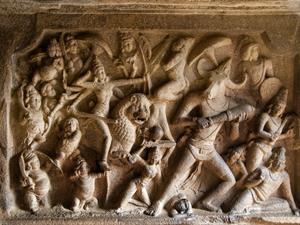PDF chapter test TRY NOW
Temple Building under the Cholas:
The Chola dynasty followed the mighty Pallava dynasty, which had carved its niche in the realm of Architecture. The Cholas who began their rule from 850 AD are come to be known as the Imperial Cholas.
They ruled for 400 years, which witnessed the zenith in the field of architecture with lofty temples and towering structures that stand the test of time.
Chola lake: The Bay of Bengal area of the subcontinent was known as Chola lake as the area was completely dominated by the naval forces of Chola.
The architecture of the Cholas can be segregated into two time frames as the periods witnessed unique developments.
The Period of Early Cholas:
The temples built during the early Chola period followed a particular style of architecture named the “Sembian Mahadevi”. They were not large in appearance. Dwarf figures named “Gana’s” are found in the walls of the temples.

Koranganatha Temple Carvings
The Cholas are the patrons of Shaivism, and the temples they built were mostly for the devotion of “Lord Shiva”. The Ganas are found in all the Shiva temples as they were considered to be the most devoted to the lord.
Sembian style: The Queen Sembian Mahadevi, replaced most of the brick temples with stone ones during her rule. Her period also witnessed the increase in the number of “Niches” figures in temple walls. This unique style of architecture was named the “Sembian Style”.
Temples of Sembian styles are found in Karandai, Thirupurambiyam and Aduthurai. These temples personified a unique style that was not found in other contemporary temples.
Some of the notable early Chola temples are:
1. Vijayalaya Choliswara temple
2. Mooverkovil
3. Brahmapurisvara temple
4. Koranganatha Temple
The Later Cholas, belonging to the 11^{th} century, showed keen interest in developing the architecture under their rule. Some of the important developments that took place during this period are given below.
1. The Sanctum of the Chola temples (both square and circle in shape).
2. Beautification of the inner side of external walls took place.
3. Erection of Vimanas.
4. Shikaras and Kalasa’s were built on top of the Gopurams.
5. Pillared mandapams were constructed to conduct festivals.
